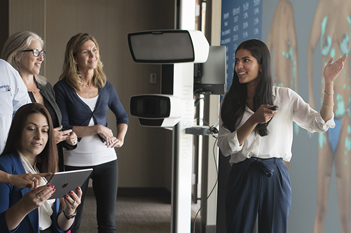"Assessment of the Reproducibility and Accuracy of the VISIA® Complexion Analysis Camera System for Objective Skin Analysis of Facial Wrinkles and Skin Age" Featured in GMS Interdisciplinary Plastic and Reconstructive Surgery DGPW
Objective: This study aimed to investigate the reproducibility and accuracy of the Visia® Complexion Analysis Camera System by Canfield Scientific for objective skin analysis.
Methods: Nineteen participants underwent facial capture with the Visia® camera following a standardised protocol. During the first session, the participants sat down and positioned their faces in a capture rig, closed their eyes and had their faces captured from the left, front and right sides, with threefold repetition of the captures from the front side. After 4 weeks, the participants underwent recapture in a similar manner. Based on the frontal views, data for two measurement methods of the Visia® camera system, the absolute scores and the percentiles, were obtained with regard to the skin criterion wrinkles via automated software calculation. Means and standard deviations were evaluated. Based on the side views, the data for the Truskin Ages® were calculated by the Visia® camera system and compared with the calendrical ages, which served as the gold standard for comparison.
Results: In the assessment of the reproducibility of the data of the capture system the standard deviation from the frontal captures among all participants was about 3% when the absolute scores of the wrinkles were compared with each other; specifically, the average deviation was 3.36% during the first capture session and 3.4% during the second capture session. Meanwhile, the standard deviation of the measurements was about 9% when the percentiles were compared; specifically, the average deviation was 8.2% during the first capture session and 10.7% during the second capture session.
In the assessment of the accuracy the correlation between the calendrical age and the calculated Truskin Age® for both facial sides was very high at a correlation coefficient rho value of >0.8 (right side: r=0.896; left side: r=0.827) and statistically significant at a p-value of <0.001.
The average calendrical age and Truskin Age® deviated only slightly from each other and did not differ significantly (right side: p=0.174; left side: p=0.190). The Truskin Age® was slightly higher than the calendrical age by a mean value of 1.37 years for both facial sides.
The analysis of the absolute differences revealed that in 50% of the cases, there was a maximum difference of 3 years, and in 75% of the cases, there were maximum differences of 4.5 years for the right side and 5.5 years for the left side.
Conclusion: The assessment of the reproducibility and accuracy of the objective measurement method, the Visia® camera system, contributed to the validation of the system.
The evaluation of the reproducibility revealed a satisfactory precision of the repeated captures when investigating facial wrinkles. Absolute scores should be preferred over percentiles owing to their better precision.
The calculation of the accuracy of the Truskin Age® data from the Visia® camera system revealed only a slight deviation from the true calendrical ages. The correlation between both data groups was highly significant.
Most Recent News
- Canfield’s VECTRA® WB360 is on Wheels! Australian Skin Cancer Foundation Launches New 3D Skin Check Mobile Clinic
- VISIA® Wins Best Imaging Device in MedEsthetics’ Readers’ Choice Awards!
- Canfield Scientific Concludes Successful Innovations in Imaging: A Canfield Symposium in Berlin
- Canfield Scientific’s Clinical Imaging Services Support BirchBioMed Inc.’s Phase II / III Scar Treatment Trial
